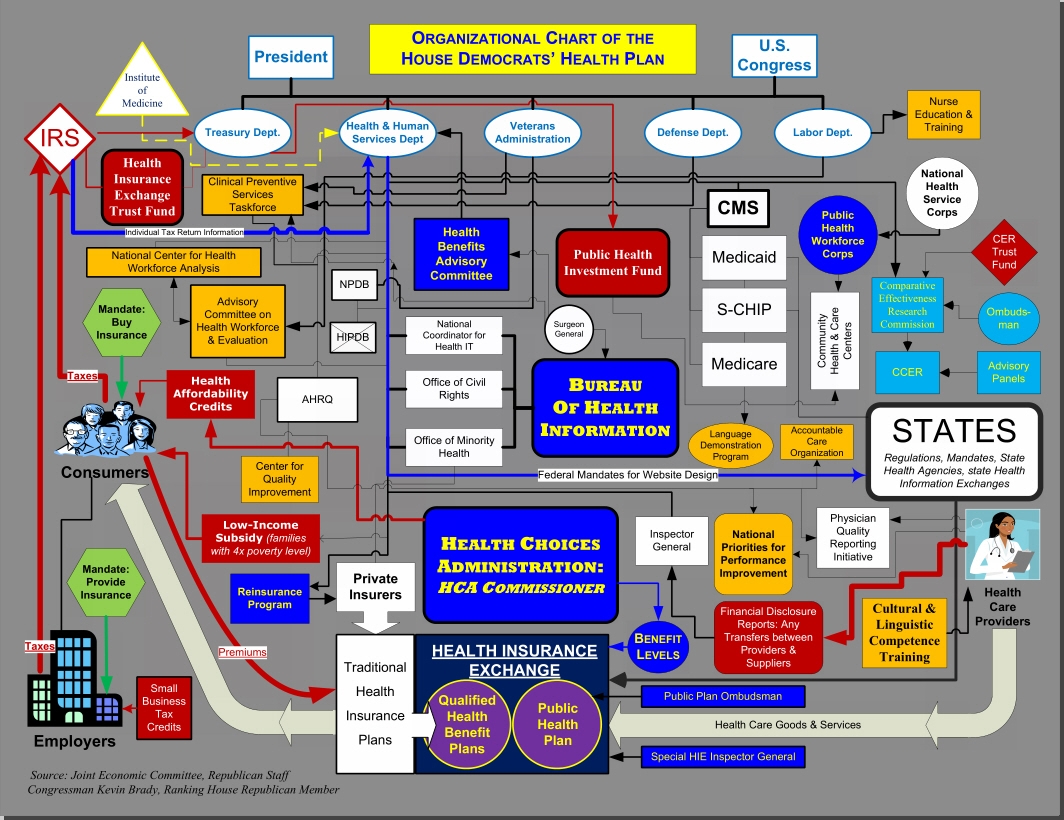Bending the curve of cost growth has been a expanding issue within health policy discussions – as opposed to the public plan option, which has increasingly been the focus of political health discussions. Recognizing how important cost growth is to health reform, the September/October issue of Health Affairs is dedicated to this topic, and it contains great articles describing various factors causing spending to grow faster than the GDP or general inflation, and some solutions to this ongoing conundrum. However, these articles are like trees in the forest, i.e., they are very important, but a close examination of each one doesn’t provide a broad understanding of the whole forest – or in this case, what bending the curve of healthcare cost growth might look like.…
Healthcare Reform’s Hurricane Warnings
Before the start of the hurricane season, the National Hurricane Center at NOAA issues predictions for how many storms and major hurricanes are expected that year. Political analysts often put forth such prognostications based upon trends in polling winds, the temperature of the electorate and the country’s economy, etc. Healthcare is the biggest storm brewing in US politics, and Charlie Cook and Ron Brownstein are both raising hurricane warning flags for the Democrats.
In the last two issues of the National Journal (9/5 & 9/12) they directly and indirectly discuss the political implications of health reform legislation for Democrats in the 2010 and 2012 elections. …
Kennedy Legacies for Health Reform
In preparation for Congress reconvening today – and to spin up activits’ energy ahead of the President’s health reform speech on Wednesday – there was a rally yesterday on the Boston Common. (See pictures below.)
Because this event was in Massachusetts, the speakers – and many of the hand-held signs – referred to Senator Ted Kennedy’s decades of work on healthcare, and invoked his memory to energize the reform efforts. From an historical perspective, in addition to Ted Kennedy’s legacy the words and deeds of his brothers JFK and RFK may also be important for creating social momentum for improving healthcare in the US.…
Beyond Health Insurance Reform: Transforming Health Care Delivery
“Health insurance reform” has become the latest label for national health reform legislation, but this renaming has pushed discussion about how to transform healthcare delivery farther back into a poorly lit corner of the debate.
Transforming the delivery of healthcare can improve quality and efficiency because the current system has two fundamental impairments: 1) lack of integration and coordination among clinicians and organizations like hospitals, and 2) a shortage of primary care clinicians. There have been many proposals for how to address these structural problems, but they have tended to not be bold enough, i.e., they would take many years – and in some cases decades – to produce significant results.…
Miscommunicating Health Reform
Anyone following the debate about health reform knows that the discourse has become increasingly uncivil. While it is easy to blame those opposing the proposals being developed in Congress for this situation, supporters of the proposals have been validating their adversaires’ messages by repeating the misrepsentative labels in their rebuttals.
Specifically, critics of the overall proposal have mischaracterized a provision that would pay clinicians for discussing end of life care preferences with their patients enrolled in Medicare. (See below for information about the provision.) Unfortunately, in responding to these attacks, health reform supporters have repeated the false claims about the provision, (and the label “Death Panels”), and thus perpetuated the fear their opponents have created.…
Health Reform Fact and Fiction
In this blog I try to explain the meaning of different aspects of healthcare reform, delivery, financing, research, etc. Sticking to that goal has left me a bit stymied in seeking to write about the current state of the “debate” as it is being played out in Congressional town hall meetings and in the press via partisan talking heads.
My simplistic conclusion is that the balance between policy and politics has now swung so far and hard to one side that the needle is firmly wedged against the peg of politics. While the needle may bend from all this pressure, it doesn’t seem to be leading to any improvement of healthcare costs or quality. …
What is Health Reform, and Why?
As Congress enters the August district work period, (the official name for the August recess), the debate about health reform has shifted from Congressional hearings and mark-ups to local Town Hall meetings, the media, (print, talk radio, talking heads on TV, and the blogo-YouTube-osphere), and the astroturf campaign styled world of organized phone banks, shout downs, and meetup/get-together rallies/service days.
Proponents and opponents on all sides are participating in and supporting all these types of activities. But the questions I keep getting are, “what is the proposal?” “What is in the President’s bill?” “What is health reform?”
Simply answered, 1) There is no single proposal – three House Committees have passed bills, (which need to be melded into one bill for consideration by the full House of Representatives in the fall), and one Senate Committee has passed a bill and another is still trying to cobble together a bipartisan bill; 2) The President has 3-4 principles, but doesn’t have his own “bill”; and 3) That is still being determined – but if you listen to the escalating frenzy, (which is why I frequently wear earbuds that may or may not be connected to an MP3 player), health reform is all about a public insurance plan option.…
Real Health Reform in Massachusetts
The Massachusetts Special Commission on Payment Reform recently issued its recommendations for shifting the state’s health care system from Fee-For-Service (FFS) to Global Payments over a 5 year period. The Special Commission’s report lays out a good case for making this change, describing why it needs to be adopted by all payers, (although each payer would still pay different rates, they would all use the same fundamental global payment structure), and some of the challenges for successfully navigating a 5 year transition period from the current mostly FFS system to one dominated by global payments.
The report summarizes its recommendations into 9 areas:
- The development of Accountable Care Organizations (ACOs).
Unfortunate Diversion from Health Reform Message
It was unfortunate that President Obama answered the question about Professor Gates at his news conference last night because it has dramatically diluted the focus of his message from health care reform to this unrelated story. Many news organizations are covering his remarks on that one subject with less recognition of his health care reform message. While the Washington Post and NY Times lead with the health message, they also include articles about the Professor Gates. Conversely, the Boston Globe (not surprisingly) and CNN.com highlight the Professor Gates story over healthcare. (MSNBC.com and cbsnew.com have health reform coverage more prominently that the Professor Gates story, while abcnews.com…
Making Health Reform’s Parts Work Together – Keeping It From Jamming
As health reform legislation moves forward, (having been passed by one of the two Senate Committees and two of the three House Committees last week), the tension between policy and politics is increasing. This political process can make it hard to maintain the practical functionality of the legislation, i.e. not sacrificing the substantive policy goals to the political realities.
One of the great challenges in making these trade-offs is to retaining reasonable functional relationships among the many necessary financing and delivery system changes to actually improve the healthcare system.
Keeping the Implementation of Health Reform from Getting Jammed Up
An analogy for this challenge came to mind when I was in DC last week. …
Health Reform Hyperbole Heightens
With Congress in the midst of considering health reform legislation, the slanting rhetoric about the proposals is escalating. For example, TV shows such as The Daily Show are covering the debate, and Congressional Republicans have put out a graphic showing their view of the health system the proposal from the Democrats in the House of Representatives would create:
What I find very, very, very interesting in this view, (prepared by Republican Congressional staff), is the top line of the graphic showing the US Congress operating on an equal basis with the President in running the Federal Departments of Treasure, HHS, VA, Defense, and Labor. …
Wavering Health Reform
As news of some disharmony in the efforts to reach consensus for health reform legislation sprayed out from Washington, I’ve been trying to find the words to explain what this means. It’s always been clear that the “devil is in the details” and that when it came time to forge enough agreement to pass legislation, (as it did last week), there would be ups and downs as provisions are modified, dropped and added.
Beyond that simple description, it would take many, many words to explain how the process for achieving success in health reform legislation could work. So instead, below are some pictures, that I hope will be worth thousands of words more than the brief comment below each one.…


